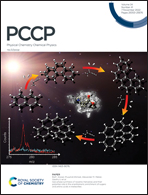Mo3(C6O6)2 monolayer as a promising electrocatalyst for the CO2 reduction reaction: a first-principles study†
Abstract
Designing electrocatalysts with good electrical conductivity, low cost, and abundant surface active sites to actively and selectively catalyze the CO2 reduction reaction (CRR) is crucial for mitigating the impact of high carbon emissions. By performing first principles calculations, the potential of Mo3(C6O6)2 monolayers as CRR electrocatalysts was explored by systematically examining the thermodynamic processes of all possible elementary steps. The Mo centers turn out to be the active sites that can selectively promote CRR and produce methane as the main product. The limiting potential for the potential-determining step (PDS) of the first reaction cycle is −0.58 V, less negative than that of the widely studied Cu(211) surface (−0.74 V). For subsequent reaction cycles, the Mo sites tend to coordinate with hydroxyl, which can further promote the CRR and lower the thermodynamic barrier of the PDS to 0.39 eV and suppress the side reaction of hydrogen evolution. With good conductivity and high catalytic activity and selectivity, the hydroxyl terminated Mo3(C6O6)2 monolayer is predicted to be an effective electrocatalyst for CRR.



 Please wait while we load your content...
Please wait while we load your content...